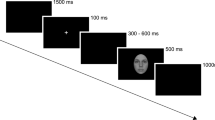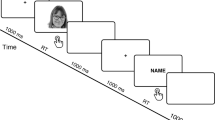Abstract
Establishing when and how the human brain differentiates between object categories is key to understanding visual cognition. Event-related potential (ERP) investigations have led to the consensus that faces selectively elicit a negative wave peaking 170 ms after presentation, the 'N170'. In such experiments, however, faces are nearly always presented from a full front view, whereas other stimuli are more perceptually variable, leading to uncontrolled interstimulus perceptual variance (ISPV). Here, we compared ERPs elicited by faces, cars and butterflies while—for the first time—controlling ISPV (low or high). Surprisingly, the N170 was sensitive, not to object category, but to ISPV. In addition, we found category effects independent of ISPV 70 ms earlier than has been generally reported. These results demonstrate early ERP category effects in the visual domain, call into question the face selectivity of the N170 and establish ISPV as a critical factor to control in experiments relying on multitrial averaging.
This is a preview of subscription content, access via your institution
Access options
Subscribe to this journal
Receive 12 print issues and online access
$209.00 per year
only $17.42 per issue
Buy this article
- Purchase on Springer Link
- Instant access to full article PDF
Prices may be subject to local taxes which are calculated during checkout







Similar content being viewed by others
References
Bentin, S., Allison, T., Puce, A., Perez, E. & McCarthy, G. Electrophysiological studies of face perception in humans. J. Cogn. Neurosci. 8, 551–565 (1996).
Jeffreys, D.A. Event-related potential studies of face and object processing. Vis. Cogn. 3, 1–38 (1996).
Eimer, M. & McCarthy, R.A. Prosopagnosia and structural encoding of faces: evidence from event-related potentials. Neuroreport 10, 255–259 (1999).
Eimer, M. Effects of face inversion on the structural encoding and recognition of faces. Evidence from event-related brain potentials. Brain Res. Cogn. Brain Res. 10, 145–158 (2000).
Itier, R.J. & Taylor, M.J. N170 or N1? Spatiotemporal differences between object and face processing using ERPs. Cereb. Cortex 14, 132–142 (2004).
Itier, R.J., Latinus, M. & Taylor, M.J. Face, eye and object early processing: what is the face specificity? Neuroimage 29, 667–676 (2006).
Liu, J., Higuchi, M., Marantz, A. & Kanwisher, N. The selectivity of the occipitotemporal M170 for faces. Neuroreport 11, 337–341 (2000).
Xu, Y., Liu, J. & Kanwisher, N. The M170 is selective for faces, not for expertise. Neuropsychologia 43, 588–597 (2005).
Rossion, B., Curran, T. & Gauthier, I. A defense of the subordinate-level expertise account for the N170 component. Cognition 85, 189–196 (2002).
Gauthier, I., Curran, T., Curby, K.M. & Collins, D. Perceptual interference supports a nonmodular account of face processing. Nat. Neurosci. 6, 428–432 (2003).
Pegna, A.J., Khateb, A., Michel, C.M. & Landis, T. Visual recognition of faces, objects and words using degraded stimuli: where and when it occurs. Hum. Brain Mapp. 22, 300–311 (2004).
Lueschow, A. et al. Looking for faces: attention modulates early occipitotemporal object processing. Psychophysiology 41, 350–360 (2004).
Carmel, D. & Bentin, S. Domain specificity versus expertise: factors influencing distinct processing of faces. Cognition 83, 1–29 (2002).
Cauquil, A.S., Edmonds, G.E. & Taylor, M.J. Is the face-sensitive N170 the only ERP not affected by selective attention? Neuroreport 11, 2167–2171 (2000).
Rossion, B., Gauthier, I., Goffaux, V., Tarr, M.J. & Crommelinck, M. Expertise training with novel objects leads to left-lateralized face-like electrophysiological responses. Psychol. Sci. 13, 250–257 (2002).
Hillyard, S.A. & Picton, T.W. Electrophysiology of cognition. in Handbook of Physiology: Section 1. The Nervous System (ed. F. Plum) 519–584 (Waverly Press, Bethesda, Maryland, 1987).
Tarkiainen, A., Cornelissen, P.L. & Salmelin, R. Dynamics of visual feature analysis and object-level processing in face versus letter-string perception. Brain 125, 1125–1136 (2002).
Cornelissen, P., Tarkiainen, A., Helenius, P. & Salmelin, R. Cortical effects of shifting letter position in letter strings of varying length. J. Cogn. Neurosci. 15, 731–746 (2003).
Rossion, B., Joyce, C.A., Cottrell, G.W. & Tarr, M.J. Early lateralization and orientation tuning for face, word and object processing in the visual cortex. Neuroimage 20, 1609–1624 (2003).
Liu, J., Harris, A. & Kanwisher, N. Stages of processing in face perception: an MEG study. Nat. Neurosci. 5, 910–916 (2002).
Schweinberger, S.R., Pickering, E.C., Jentzsch, I., Burton, A.M. & Kaufmann, J.M. Event-related brain potential evidence for a response of inferior temporal cortex to familiar face repetitions. Brain Res. Cogn. Brain Res. 14, 398–409 (2002).
Schweinberger, S.R. & Burton, A.M. Covert recognition and the neural system for face processing. Cortex 39, 9–30 (2003).
Boehm, S.G., Klostermann, E.C. & Paller, K.A. Neural correlates of perceptual contributions to nondeclarative memory for faces. Neuroimage 30, 1021–1029 (2006).
Allison, T. et al. Face recognition in human extrastriate cortex. J. Neurophysiol. 71, 821–825 (1994).
Allison, T., Puce, A., Spencer, D.D. & McCarthy, G. Electrophysiological studies of human face perception. I: potentials generated in occipitotemporal cortex by face and nonface stimuli. Cereb. Cortex 9, 415–430 (1999).
Seeck, M. et al. Evidence for rapid face recognition from human scalp and intracranial electrodes. Neuroreport 8, 2749–2754 (1997).
Seeck, M. et al. Intracranial neurophysiological correlates related to the processing of faces. Epilepsy Behav. 2, 545–557 (2001).
Krolak-Salmon, P., Henaff, M.A., Vighetto, A., Bertrand, O. & Mauguiere, F. Early amygdala reaction to fear spreading in occipital, temporal and frontal cortex: a depth electrode ERP study in human. Neuron 42, 665–676 (2004).
Bennett, T.L. Cognitive effects of epilepsy and anticonvulsant medications. in The Neuropsychology of Epilepsy (ed. T.L. Bennett) 73–95 (Plenum Press, New York, 1992).
Vuilleumier, P., Henson, R.N., Driver, J. & Dolan, R.J. Multiple levels of visual object constancy revealed by event-related fMRI of repetition priming. Nat. Neurosci. 5, 491–499 (2002).
Eimer, M. The face-specific N170 component reflects late stages in the structural encoding of faces. Neuroreport 11, 2319–2324 (2000).
Herrmann, M.J., Ehlis, A.C., Ellgring, H. & Fallgatter, A.J. Early stages (P100) of face perception in humans as measured with event-related potentials (ERPs). J. Neural Transm. 112, 1073–1081 (2005).
Herrmann, M.J., Ehlis, A.C., Muehlberger, A. & Fallgatter, A.J. Source localization of early stages of face processing. Brain Topogr. 18, 77–85 (2005).
Schendan, H.E., Ganis, G. & Kutas, M. Neurophysiological evidence for visual perceptual categorization of words and faces within 150 ms. Psychophysiology 35, 240–251 (1998).
Linkenkaer-Hansen, K. et al. Face-selective processing in human extrastriate cortex around 120 ms after stimulus onset revealed by magneto- and electroencephalography. Neurosci. Lett. 253, 147–150 (1998).
Grill-Spector, K. & Malach, R. fMR-adaptation: a tool for studying the functional properties of human cortical neurons. Acta Psychol. (Amst.) 107, 293–321 (2001).
CVL face database. Faculty of Computer and Information Science. University of Ljubljana, Slovenia.http://www.lrv.fri.uni-lj.si/facedb.html.
Lehmann, D. Principles of spatial analysis. in Handbook of Electroencephalography and Clinical Neurophysiology (ed. A.S. Gevins & A. Remond) 309–354 (Elsevier, Amsterdam, 1987).
Michel, C.M. et al. Electric source imaging of human brain functions. Brain Res. Brain Res. Rev. 36, 108–118 (2001).
Pegna, A.J. et al. Unraveling the cerebral dynamics of mental imagery. Hum. Brain Mapp. 5, 410–421 (1997).
Michel, C.M., Seeck, M. & Landis, T. Spatiotemporal dynamics of human cognition. News Physiol. Sci. 14, 206–214 (1999).
Pascual-Marqui, R.D., Michel, C.M. & Lehmann, D. Segmentation of brain electrical activity into microstates: model estimation and validation. IEEE Trans. Biomed. Eng. 42, 658–665 (1995).
Lehmann, D. & Skrandies, W. Reference-free identification of components of checkerboard-evoked multichannel potential fields. Electroencephalogr. Clin. Neurophysiol. 48, 609–621 (1980).
Acknowledgements
The authors thank M. Roberts, S. Boehm, D. Linden, S. Tipper, K. Djali, E. Stevens, M. Thoré, C. Willmes and P. Zeller for assistance and comments. Some of the face images used in this work have been provided by the Computer Vision Laboratory, University of Ljubljana, Slovenia. Data were analyzed using “Cartool” (http://brainmapping.unige.ch/cartool.php, by D. Brunet, Center for Biomedical Imaging of Geneva and Lausanne, Switzerland). G.T. is funded by the Biotechnology and Biological Science Research Council UK (S18007) and the Economic and Social Research Council (RES-000-23-0095). C.D.M. is funded by the Fyssen Foundation. A.J.P. is funded in part by the Swiss National Foundation for Scientific Research (grant 320000-109928). P.D. is funded by the Biotechnology and Biological Science Research Council UK.
Author information
Authors and Affiliations
Contributions
G.T. conceived Experiments 1 and 3, analyzed ERP data of Experiment 1, supervised overall data analysis and wrote the manuscript. C.D.M. conceived Experiment 2 and analyzed ERP data of Experiment 2 and 3. P.D. performed pixel-wise correlation analyses, provided expertise on neuroanatomical interpretations and wrote parts of the manuscript. A.J.P. performed the segmentation analyses and wrote parts of the manuscript.
Corresponding author
Ethics declarations
Competing interests
The authors declare no competing financial interests.
Rights and permissions
About this article
Cite this article
Thierry, G., Martin, C., Downing, P. et al. Controlling for interstimulus perceptual variance abolishes N170 face selectivity. Nat Neurosci 10, 505–511 (2007). https://doi.org/10.1038/nn1864
Received:
Accepted:
Published:
Issue Date:
DOI: https://doi.org/10.1038/nn1864
This article is cited by
-
The ERP and psychophysical changes related to facial emotion perception by expertise in Japanese hospitality, “OMOTENASHI”
Scientific Reports (2022)
-
Robot faces elicit responses intermediate to human faces and objects at face-sensitive ERP components
Scientific Reports (2021)
-
Prior knowledge promotes hippocampal separation but cortical assimilation in the left inferior frontal gyrus
Nature Communications (2020)
-
Elucidating the neurophysiological underpinnings of autism spectrum disorder: new developments
Journal of Neural Transmission (2014)
-
Emotion Effects on the N170: A Question of Reference?
Brain Topography (2013)



